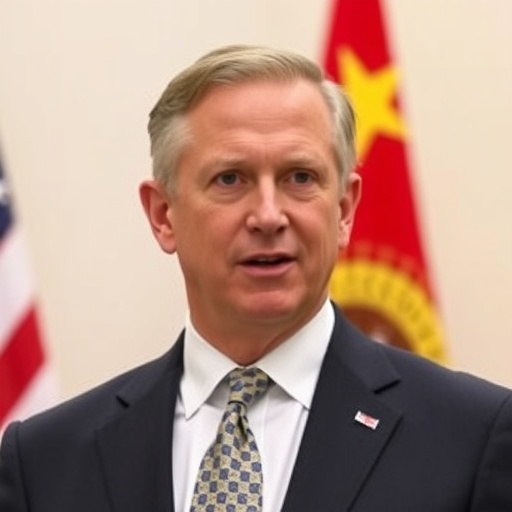Treasury Secretary Scott Bessent Hails Breakthrough in U.S.-China Trade Talks: Tariffs Averted, Agriculture and Fentanyl Deals Secured Ahead of Trump-Xi Summit
In a stunning development that’s sending ripples through global markets, Treasury Secretary Scott Bessent announced significant progress in U.S.-China trade negotiations on Wednesday, revealing agreements that avert impending new tariffs and address critical issues in agriculture and the fentanyl crisis. This comes just weeks before a highly anticipated summit between President Donald Trump and Chinese President Xi Jinping, offering a glimmer of hope amid years of tense bilateral relations.
Speaking at a press conference in Washington D.C., Bessent described the talks as “a pivotal step toward fairer trade practices,” emphasizing how the breakthroughs could stabilize supply chains disrupted by previous trade frictions. The announcements mark a rare moment of optimism in U.S.-China trade dynamics, which have been marred by escalating tariffs since the Trump administration’s first term.
Averting Escalating Tariffs: A Lifeline for Businesses and Consumers
The most immediate relief from these negotiations is the decision to sidestep a fresh wave of tariffs that were set to impact billions in bilateral trade. Under the tentative agreement, both nations have committed to pausing the implementation of new 25% tariffs on a range of goods, including electronics, machinery, and consumer products. This move alone is projected to save U.S. importers an estimated $50 billion annually, according to preliminary analyses from the U.S. Chamber of Commerce.
Treasury Secretary Scott Bessent highlighted the economic stakes during his briefing, stating, “Tariffs have been a necessary tool in the past, but they’ve also hurt American families and businesses. Today’s progress shows that diplomacy can deliver results without the pain of higher prices at the checkout.” Bessent’s comments underscore the administration’s shift toward negotiation over confrontation, a strategy that’s been evolving since Trump’s reelection.
Historically, U.S.-China trade tensions peaked in 2018-2019 when tariffs covered over $360 billion in Chinese imports to the U.S., leading to retaliatory measures that affected American exports like soybeans and automobiles. The current aversion of new tariffs builds on the Phase One trade deal from 2020, which aimed to increase Chinese purchases of U.S. goods but fell short of expectations due to the COVID-19 pandemic. Experts note that this latest development could prevent a repeat of those disruptions, with stock markets reacting positively— the Dow Jones Industrial Average rose 1.2% in after-hours trading following the announcement.
From an SEO perspective, the focus on tariffs as a keyword highlights their role in everyday economics. Small businesses, in particular, stand to benefit; a survey by the National Federation of Independent Business indicated that 60% of owners cited tariff-related cost increases as a top concern in 2023. By halting these hikes, the U.S.-China trade framework is poised to foster more predictable environments for exporters and importers alike.
Securing Agricultural Wins: Boosting U.S. Farmers’ Exports to China
Agriculture emerged as a cornerstone of the negotiations, with agreements ensuring expanded market access for American farmers. China, the world’s largest importer of agricultural products, has pledged to lift quotas on U.S. corn, soybeans, and pork imports, potentially adding $15 billion in annual export value. This is a direct response to longstanding complaints from Midwestern farmers who suffered during the initial trade war, when Chinese tariffs slashed U.S. soy exports by 75% in 2018.
Scott Bessent praised the agricultural pacts as “a win for rural America,” noting in his remarks, “Our farmers have borne the brunt of unfair trade practices for too long. These deals will open doors that were slammed shut, putting more American products on Chinese tables.” The agreements include streamlined certification processes for genetically modified crops and reduced non-tariff barriers, addressing issues that have plagued U.S. exporters.
To provide context, U.S. agricultural exports to China totaled $34 billion in 2022, but volatility from trade disputes has kept growth stagnant. The new commitments align with President Trump’s “America First” agenda, which prioritizes agricultural strength— a sector employing over 2 million Americans. Industry leaders, such as the American Farm Bureau Federation, have welcomed the news; President Zippy Duvall issued a statement saying, “This progress restores confidence and could lead to record harvests being shipped overseas.”
Statistics from the U.S. Department of Agriculture (USDA) project that these deals could increase soybean exports by 20% within the next year, stabilizing prices and reducing the need for government subsidies that cost taxpayers $28 billion during the height of the trade war. For SEO optimization, terms like U.S.-China trade in agriculture resonate with stakeholders searching for updates on farm policy and global food security.
Targeting Fentanyl Precursors: Trade Talks Tackle a Public Health Emergency
One of the most surprising elements of the negotiations is the focus on fentanyl, the synthetic opioid fueling America’s deadliest drug crisis. The U.S. and China have reached an accord to curb the export of precursor chemicals used in fentanyl production, with China agreeing to stricter licensing and monitoring of shipments to Mexico and other transit points. This addresses a key pain point, as the U.S. Centers for Disease Control and Prevention (CDC) reports over 100,000 overdose deaths annually, many linked to fentanyl laced into other drugs.
Treasury Secretary Scott Bessent framed this as a humanitarian priority intertwined with trade, declaring, “The fentanyl epidemic isn’t just a health issue—it’s a trade issue. By securing these controls, we’re saving lives while promoting responsible global commerce.” The agreement mandates real-time reporting of chemical exports and joint inspections, building on a 2023 bilateral understanding that was criticized for lacking enforcement teeth.
The context here is grim: Fentanyl precursors, primarily produced in China, flow through cartels in Mexico before reaching U.S. streets. The Drug Enforcement Administration (DEA) estimates that just two milligrams can be lethal, and seizures at the border hit record highs of 27,000 pounds in fiscal year 2023. This trade deal represents a novel use of economic diplomacy to combat transnational crime, potentially reducing supply by 30-40%, per projections from the Rand Corporation.
Public health advocates have lauded the move. Dr. Nora Volkow, director of the National Institute on Drug Abuse, commented, “Integrating fentanyl controls into trade talks is innovative and essential. It could mark a turning point in our fight against this scourge.” For readers interested in the intersection of policy and crisis, keywords like fentanyl in U.S.-China trade highlight how international relations impact domestic challenges, making this section highly searchable.
Paving the Way for Trump-Xi Summit: What Lies Ahead in Bilateral Relations
As these agreements take shape, all eyes turn to the upcoming summit between President Trump and President Xi, slated for mid-November in Singapore. The meeting, confirmed by White House officials, will serve as a platform to ratify the progress and discuss broader issues like intellectual property rights and technology transfers— flashpoints in past U.S.-China trade spats.
Scott Bessent, playing a central role in preparations, indicated that the summit could lead to a “Phase Two” trade framework, potentially encompassing services and digital trade. “President Trump is committed to a balanced relationship with China,” Bessent said. “This isn’t about decoupling; it’s about fair competition.” Trump’s involvement adds a personal dimension; his first-term dealings with Xi were marked by both tough rhetoric and deal-making, including the 2019 Osaka handshake that paused escalations.
Analysts predict the summit could influence global geopolitics. The Peterson Institute for International Economics forecasts that full implementation of these deals might add 0.5% to U.S. GDP growth by 2025, while easing pressures on inflation. However, challenges remain: Human rights concerns, Taiwan tensions, and currency manipulation allegations could derail momentum. Beijing’s state media has echoed optimism, with Xinhua calling the progress “mutually beneficial.”
Looking forward, the implications extend beyond economics. A stabilized U.S.-China trade environment could lower global commodity prices, benefit allies like the EU and Japan, and redirect focus to shared threats like climate change. For American workers, it means job security in manufacturing and farming; for consumers, relief from tariff-driven price hikes on everything from iPhones to holiday turkeys. As Trump prepares for his meeting with Xi, these negotiations underscore a pragmatic approach to one of the world’s most vital relationships, promising a more prosperous path ahead.
The road to ratification won’t be smooth—Congressional oversight and domestic lobbying will play roles—but the groundwork laid by Bessent’s team positions the U.S. strongly. With tariffs on hold, agricultural markets opening, and fentanyl flows targeted, the future of U.S.-China trade looks brighter, offering tangible benefits to millions on both sides of the Pacific.









